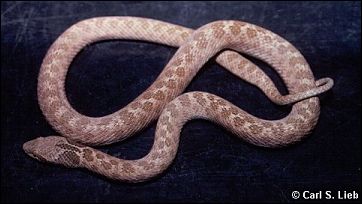
Who hasn't seen pictures of a striking rattlesnake with wide-open mouth, fangs extended and virtually dripping venom. Not all poisonous snakes are quite that dramatic, though, and not all venoms are created equal. In the animal world, poisons usually are for subduing prey rather than defensive in nature, and since manufacturing venom tends to be costly in terms of energy, the simplest that will do the job is ideal.
One of the very common snakes of the Chihuahuan Desert is the Night
Snake, and most biologists have no hesitancy in picking one up. Yet, technically, they
are poisonous, possessing a relatively mild venom that helps incapacitate their prey of
lizards, small snakes, and mice. Unlike the rattlesnakes, who employ fangs like
hypodermic needles at the front of their mouths, Night Snakes are rear-fanged serpents
whose grooved teeth lie far back in the jaws. In reality, humans have to fear only a
small portion of those members of the animal kingdom that depend on poison for taking
their prey. Now plants—that's an entirely different ball of wax! 
Contributor: Arthur H. Harris, Laboratory for Environmental Biology, Centennial Museum, University of Texas at El Paso.
Desert Diary is a joint production of the Centennial Museum and KTEP National Public Radio at the University of Texas at El Paso.

Night Snake (Hypsiglena torquata). Photograph by Carl S. Lieb.